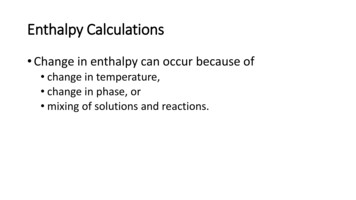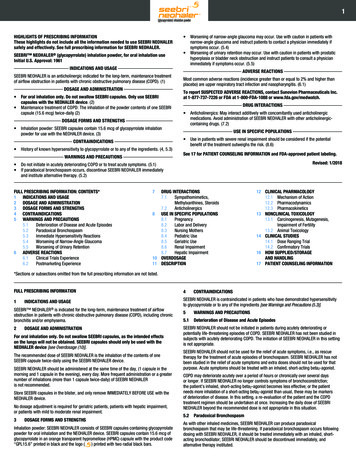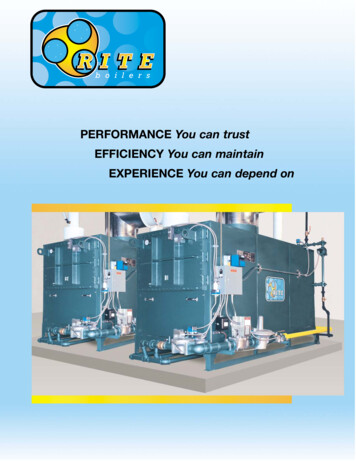
Transcription
Enthalpy Calculations Change in enthalpy can occur because of change in temperature, change in phase, or mixing of solutions and reactions.
Enthalpy Change as a Result of Temperature Sensible heat is the heat transferred to raise or lower thetemperature of a material in the absence of phase change. In the energy balance calculations, sensible heat change isdetermined by using a property of matter called the heat capacity atconstant pressure, or just heat capacity (CP). Units for CP are(J/mol/K) or (cal/g/ C). There are several methods for calculating enthalpy change using CPvalues. When CP is constant, the change in the enthalpy of asubstance due to change in temperature at constant pressure is givenby
Heat capacities for most substances vary with temperature where thevalues of CP vary for the range of the change in temperature. Heatcapacities are tabulated as polynomial functions of temperature suchas Sometimes, you need an estimate of specific enthalpy, specificinternal energy, or specific volume at a temperature and a pressurethat is between tabulated values. In this case, one can use a linearinterpolation.
Constant Heat Capacity At constant P, Δh h2 – h1
Example What is the change in the enthalpy of 100 g/s acid heated in a doublepipe heat exchanger from 20 C to 80 C, if the average heat capacity atconstant pressure is 0.50 cal/g C?
Solution
Problem Liquid water is fed to a boiler at 23 C under a pressure of 10 bar, andis converted at constant pressure to saturated steam. Calculate Δh for this process and the heat input required forproducing 15,000 m3/h of steam at the exit conditions. Assume that the inlet velocity of liquid entering the boiler is negligibleand that the steam is discharged through a 0.15 m inner diameterpipe. Inlet and exit pipes are at the same level.
Solution Known quantities: Water inlet conditions (23 C under a pressure of10 bar), exit steam conditions (10 bar, saturated steam), exit steamvolumetric flow rate (15,000 m3/h), exit pipe diameter (0.15 m). Find: Change in specific enthalpy (Δh). Analysis: The reboiler is an open system, and the general energybalance equation is
Solution
Solution
Solution
Solution
Solution
Enthalpy Calculations with Phase Changes The state of a system can be changed, for example, by increasing itstemperature or changing its composition. Properties of the system whose change depends only on the initialand final states of the system but not on the manner used to realizethe change from the initial to the final state are referred to as stateproperties. Phase changes, such as evaporation and melting, are accompanied byrelatively large changes in internal energy and enthalpy, as bondsbetween molecules are broken and reformed.
Enthalpy Calculations with Phase Changes Heat transferred to or from a system, causing change of phase at constanttemperature and pressure, is known as latent heat. The types of latent heats are: Latent heat of vaporization, which is the heat required to vaporize a liquid; Latent heat of fusion, which is the heat required to melt a solid; Latent heat of sublimation, which is the heat required to directly vaporize a solid. Heat is released during condensation, and heat is required to vaporize aliquid or melt a solid.
Enthalpy Calculations with Phase Changes Sensible heat refers to heat that must be transferred to raise or lowerthe temperature of a substance without change in phase as definedearlier. The quantity of sensible heat required to produce a temperaturechange in a system can be determined from the appropriate form ofthe first law of thermodynamics. The heat capacity at constant pressure, CP, for most incompressibleliquids and solids is equal; CP Cν and for ideal gases, CP Cν R.
Enthalpy Problem Steam at a rate of 100 kg/h is used to heat a stream of gas flowing onthe tube side of a heat exchanger. The steam enters the shell side ofthe heat exchanger as saturated vapor at 10 bar of 90% quality, andexits as saturated liquid water at 10 bar. Calculate the rate of heattransfer to the gas side.
Solution
Solution954954- 192.24- 192.5
Energy Balance for Open Systems withMultiple Inputs and Multiple Outputs
Problem Thousand kilomoles per hour of a liquid mixture of 70 mol% acetoneand 30 mol% benzene is heated from 10 C to 50 C in a shell-and-tubeheat exchanger using steam as the heating medium. The steam entersthe heat exchanger in the shell as a saturated vapor at 16 bar of 90%quality, and exits as saturated liquid water at 16 bar. Calculate themass flow rate of the inlet steam required for this purpose.
Solution
Solution
Mixing Problem Hundred kilograms per hour of a saturated steam at 1 bar is mixedwith superheated steam available at 400 C and 1 bar to producesuperheated steam at 300 C and 1 bar. Calculate the amount ofsuperheated steam produced at 300 C, and the required mass flowrate of the 400 C steam.
Solution Assumptions: No change in kinetic and potential energy, no shaftwork.
Solution
Energy Balance for Bioprocesses Bioprocesses are unlike many chemical processes. Bioprocesses are notparticularly energy intensive. Fermentation and enzyme reactors are operated at temperatures andpressures close to ambient conditions, and energy input for downstreamprocessing is minimized to avoid damaging heat-labile products. Nevertheless, energy effects are important because biological catalysts arevery sensitive to heat and changes in temperature. In large-scale processes, heat released during biochemical reactions cancause cell death of enzymes, if heat is not properly removed. The law of conservation of energy means that an energy accounting systemcan be set up to determine the amount of steam or cooling water requiredto maintain optimum process temperature.
Problem A liquid at the rate of 2000 kg/h fat (20 wt% acid, 80 wt% water) at90 C is to be cooled to 7 C. Cooling is achieved by heat exchange with2700 kg/h coolant fluid initially at 2 C. The final temperature of thecoolant liquid is 50 C. The fat is flowing on the shell side and coolantliquid is on the tube side. The heat exchanger is not adiabatic, so partof the heat is lost through the exchanger walls and the rest to coolantfluid. What is the rate of heat loss from the acid solution to thesurroundings? Assume the heat capacity of acid is 1.463 (kJ/kg C).
Solution
Calculate Δhfor this process and the heat input required for producing 15,000 m3/h of steam at the exit conditions. Assume that the inlet velocity of liquid entering the boiler is negligible and that the steam is discharged through a 0.15 m inner diameter pipe. Inlet and exit pipes are at the same level. Solution Known quantities: Water inlet conditions (23 C under a pressure of 10 .











